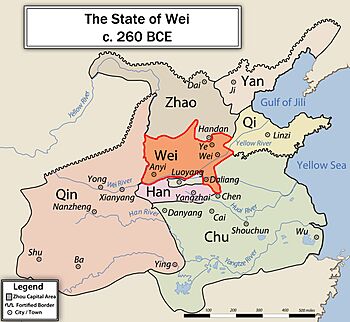Wei (state) facts for kids
Quick facts for kids
State of Wei
魏
*N-qʰuj-s |
|||||||||
|---|---|---|---|---|---|---|---|---|---|
| 403 BCE–225 BCE | |||||||||
 |
|||||||||
| Capital | Anyi (安邑, first) Daliang (大梁) |
||||||||
| Common languages | Old Chinese | ||||||||
| Government | Marquessate (侯) Kingdom (王; after 344 BCE) |
||||||||
| History | |||||||||
| 403 BCE | |||||||||
|
• Conquered by Qin
|
225 BCE | ||||||||
| Currency | spade money other ancient Chinese coinage |
||||||||
|
|||||||||
| Wei | |||||||||||||||||||||||||||||
|---|---|---|---|---|---|---|---|---|---|---|---|---|---|---|---|---|---|---|---|---|---|---|---|---|---|---|---|---|---|

"Wei" in seal script (top) and regular Chinese (bottom) characters
|
|||||||||||||||||||||||||||||
| Chinese | 魏 | ||||||||||||||||||||||||||||
|
|||||||||||||||||||||||||||||
The Wei state (pronounced "Way") was one of the most important states in ancient China. It existed during a time called the Warring States period. This period lasted from about 475 BCE to 221 BCE. Wei was formed when a larger state called Jin split into three parts. The other two parts were Han and Zhao.
Wei was located between the powerful states of Qin and Qi. Its land covered parts of what are now the Chinese provinces of Henan, Hebei, Shanxi, and Shandong. The first capital of Wei was Anyi. Later, the capital moved to Daliang (which is now Kaifeng). Because of this, Wei was sometimes also called Liang.
Contents
History of the Wei State
How Wei Began
The rulers of Wei came from a very old royal family, the Zhou family. A man named Gao, Duke of Bi, was a son of King Wen of Zhou. His family later took the name Bi. After their home was destroyed, a descendant named Bi Wan went to the Jin state. He became an important helper to the ruler of Jin.
Bi Wan was given the land of Wei after a successful military trip. His family then founded the house of Wei.
The Spring and Autumn Period Changes
The Jin state faced big changes after its ruling family was harmed. Power then spread among other important families, including the Wei family.
In the final years of the Spring and Autumn period, the families who founded Wei, Zhao, and Han worked together. They attacked and defeated another powerful family in 453 BCE. This event led to the partition of Jin, where Jin split into three states. In 403 BCE, the Zhou king officially recognized these three families as rulers of their own states. He gave their leaders the title of marquess.
Wei During the Warring States Period
The Wei state was strongest under its first two rulers, Marquess Wen of Wei and Marquess Wu of Wei. The third ruler, King Hui of Wei, decided to call himself an independent king. He focused on making Wei's economy stronger. He started big projects, like irrigation systems near the Yellow River.
King Hui thought the Qin state to the west was weak and its land was poor. So, he focused on taking over richer lands to the east. However, Wei's plans were stopped by a series of battles, including the battle of Maling in 341 BCE. While Wei struggled, Qin grew stronger in its economy and military.
Wei became strong early on because it adopted new ideas called Legalist reforms. These ideas were suggested by a wise man named Li Kui.
The Fall of Wei
Wei eventually lost a key area called Hexi to the Qin state. This was an important area of land on the west side of the Yellow River. After this, Wei was constantly at war with Qin. This forced Wei to move its capital from Anyi to Daliang.
The Wei state finally surrendered to Qin in 225 BCE. A Qin general named Wang Ben redirected the Yellow River. The river's waters flooded Daliang, destroying the capital and leading to Wei's defeat.
Rulers of Wei
Here is a list of the main rulers of the Wei state:
- Marquess Wen of Wei (445–396 BCE)
- Marquess Wu of Wei (396–370 BCE)
- King Hui of Wei (370–319 BCE)
- King Xiang of Wei (319–296 BCE)
- King Zhao of Wei (296–277 BCE)
- King Anxi of Wei (277–243 BCE)
- King Jingmin of Wei (243–228 BCE)
- King Jia (228–225 BCE)
Family Tree of Wei Rulers
| Wei state family tree | |||||||||||||||||||||||||||||||||||||||||||||||||||||||||||||||||||||||||||||||||||||||||||||||||||||||||||||||||||||||||||||||||||||||||||||||||||||||||||||||||||||||||||||||||||||||||||||||||||||||||||||||||||||||||||||||||||||||||||||||||||||||||||||||||||||||||||||||||||||||||||||||||||||||||||||||||||||||||||||||||||||||||||||||||||||||||||||||||||||||||||||||||||||||||||||||||||||||||||||||||||||||||||||||||||||||||||||||||||||||||||||||||||||||||||||||||||||||||||||||||||||||||||||||||||||||||||||||||||||||||||||||||||||||||||||||||||||||||||||||||||||||||||||||||||||||||||||||||||||||||||||||||||||||||||||||||||||||||||||||||||||||||||||||||||||||||||||||||||||||||||||||||||||||||||||||||||||||||||||||||||||||||||||||||||||||||||||||||||||||||||||||||||||||||||||||||||||||||||||||||||||||||||||||||||||||||||||||||||||||||||||||||||||||||||||||||||||||||||||||||||||||||||||||||||||||||||||||||||||||||||||||||||||||||||||||||||||||||||||||||||||||||||||||||||||||||||||||||||||||
|---|---|---|---|---|---|---|---|---|---|---|---|---|---|---|---|---|---|---|---|---|---|---|---|---|---|---|---|---|---|---|---|---|---|---|---|---|---|---|---|---|---|---|---|---|---|---|---|---|---|---|---|---|---|---|---|---|---|---|---|---|---|---|---|---|---|---|---|---|---|---|---|---|---|---|---|---|---|---|---|---|---|---|---|---|---|---|---|---|---|---|---|---|---|---|---|---|---|---|---|---|---|---|---|---|---|---|---|---|---|---|---|---|---|---|---|---|---|---|---|---|---|---|---|---|---|---|---|---|---|---|---|---|---|---|---|---|---|---|---|---|---|---|---|---|---|---|---|---|---|---|---|---|---|---|---|---|---|---|---|---|---|---|---|---|---|---|---|---|---|---|---|---|---|---|---|---|---|---|---|---|---|---|---|---|---|---|---|---|---|---|---|---|---|---|---|---|---|---|---|---|---|---|---|---|---|---|---|---|---|---|---|---|---|---|---|---|---|---|---|---|---|---|---|---|---|---|---|---|---|---|---|---|---|---|---|---|---|---|---|---|---|---|---|---|---|---|---|---|---|---|---|---|---|---|---|---|---|---|---|---|---|---|---|---|---|---|---|---|---|---|---|---|---|---|---|---|---|---|---|---|---|---|---|---|---|---|---|---|---|---|---|---|---|---|---|---|---|---|---|---|---|---|---|---|---|---|---|---|---|---|---|---|---|---|---|---|---|---|---|---|---|---|---|---|---|---|---|---|---|---|---|---|---|---|---|---|---|---|---|---|---|---|---|---|---|---|---|---|---|---|---|---|---|---|---|---|---|---|---|---|---|---|---|---|---|---|---|---|---|---|---|---|---|---|---|---|---|---|---|---|---|---|---|---|---|---|---|---|---|---|---|---|---|---|---|---|---|---|---|---|---|---|---|---|---|---|---|---|---|---|---|---|---|---|---|---|---|---|---|---|---|---|---|---|---|---|---|---|---|---|---|---|---|---|---|---|---|---|---|---|---|---|---|---|---|---|---|---|---|---|---|---|---|---|---|---|---|---|---|---|---|---|---|---|---|---|---|---|---|---|---|---|---|---|---|---|---|---|---|---|---|---|---|---|---|---|---|---|---|---|---|---|---|---|---|---|---|---|---|---|---|---|---|---|---|---|---|---|---|---|---|---|---|---|---|---|---|---|---|---|---|---|---|---|---|---|---|---|---|---|---|---|---|---|---|---|---|---|---|---|---|---|---|---|---|---|---|---|---|---|---|---|---|---|---|---|---|---|---|---|---|---|---|---|---|---|---|---|---|---|---|---|---|---|---|---|---|---|---|---|---|---|---|---|---|---|---|---|---|---|---|---|---|---|---|---|---|---|---|---|---|---|---|---|---|---|---|---|---|---|---|---|---|---|---|---|---|---|---|---|---|---|---|---|---|---|---|---|---|---|---|---|---|---|---|---|---|---|---|---|---|---|---|---|---|---|---|---|---|---|---|---|---|---|---|---|---|---|---|---|---|---|---|---|---|---|---|---|---|---|---|---|---|---|---|---|---|---|---|---|---|---|---|---|---|---|---|---|---|---|---|---|---|---|---|---|---|---|---|---|---|---|---|---|---|---|---|---|---|---|---|---|---|---|---|---|---|---|---|---|---|---|---|---|---|---|---|---|---|---|---|---|---|---|---|---|---|---|---|---|---|---|---|---|---|---|---|---|---|---|---|---|---|---|---|---|---|---|---|---|---|---|---|---|---|---|---|---|---|---|---|---|---|---|---|---|---|---|---|---|---|---|---|---|---|---|---|---|---|---|---|---|---|---|---|---|---|---|---|---|---|---|---|---|---|---|---|---|---|---|---|---|---|---|---|---|---|---|---|---|---|---|---|---|---|---|---|---|---|---|---|---|---|---|---|---|---|---|---|---|---|---|---|---|---|---|---|---|---|---|---|---|---|---|---|---|---|---|---|---|---|---|---|---|---|---|---|---|---|---|---|---|---|---|---|---|---|---|---|---|---|---|---|---|---|---|---|---|---|---|---|---|---|---|---|---|---|---|---|---|---|---|---|---|---|---|---|---|---|---|---|---|---|---|---|---|---|---|---|---|---|---|---|---|---|---|---|---|---|---|---|---|---|---|---|---|---|---|---|---|---|---|---|---|---|---|---|---|---|---|---|---|---|---|---|---|---|---|---|---|---|---|---|---|---|---|---|---|---|---|---|---|---|---|---|---|---|---|---|---|---|---|---|---|---|---|---|---|---|---|---|---|---|---|---|---|---|---|---|
|
|||||||||||||||||||||||||||||||||||||||||||||||||||||||||||||||||||||||||||||||||||||||||||||||||||||||||||||||||||||||||||||||||||||||||||||||||||||||||||||||||||||||||||||||||||||||||||||||||||||||||||||||||||||||||||||||||||||||||||||||||||||||||||||||||||||||||||||||||||||||||||||||||||||||||||||||||||||||||||||||||||||||||||||||||||||||||||||||||||||||||||||||||||||||||||||||||||||||||||||||||||||||||||||||||||||||||||||||||||||||||||||||||||||||||||||||||||||||||||||||||||||||||||||||||||||||||||||||||||||||||||||||||||||||||||||||||||||||||||||||||||||||||||||||||||||||||||||||||||||||||||||||||||||||||||||||||||||||||||||||||||||||||||||||||||||||||||||||||||||||||||||||||||||||||||||||||||||||||||||||||||||||||||||||||||||||||||||||||||||||||||||||||||||||||||||||||||||||||||||||||||||||||||||||||||||||||||||||||||||||||||||||||||||||||||||||||||||||||||||||||||||||||||||||||||||||||||||||||||||||||||||||||||||||||||||||||||||||||||||||||||||||||||||||||||||||||||||||||||||||
Notable People from Wei
- Li Kui: A wise thinker who helped create the Legalist ideas and served as a top official.
- Yue Yang: An important general and prime minister.
- Pang Juan: A successful general who was defeated in a famous battle.
Legacy of Wei
Chinese Legend
An old Chinese story tells of a king of Wei and his favorite companion. One day, they were fishing. The companion started to cry. When the king asked why, the companion said he felt like a fish. He explained that he was happy to be caught at first, but then feared being thrown back when a better fish was found. He worried the king might find someone else he liked more. To show his loyalty, the king declared that anyone who spoke of other beautiful people would be punished.
Wei in Chinese Astronomy
In traditional Chinese astronomy, the Wei state is represented by stars in the sky. One star is part of the "Twelve States" group in the "Girl" area of the sky. Another star is in the "Left Wall" of the ""Heavenly Market"". These stars might be 33 Capricorni and Delta Herculis, or Chi Capricorni and Phi Capricorni.
See also
- Liang (state), an earlier state with a similar name
- Liang (realm), how the title continued in later dynasties
- Liang (Han dynasty kingdom), a kingdom during the Han dynasty that was in the same area as Wei

